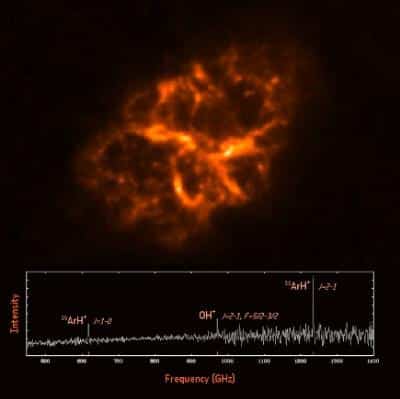One of the properties of noble gases is that they do not combine with any other substance naturally (but yes in the laboratory), however in the Cancer Nebula the intensity of the explosion was so high that it created argon hydride (a molecule containing hydrogen and argon).

A molecule containing a noble gas was discovered in space by a team of astronomers from Cardiff University.
The finding was achieved with the help of observations and measurements made by the European Herschel Space Telescope. The molecule, argon hydride (ArH), was observed in the Crab Nebula, which is the remains of a star that exploded 1000 years ago. Before this discovery, molecules of this type had only been observed in laboratories on Earth.
The noble gases, which include the gases helium, argon, radon and krypton, usually do not react easily with other chemical elements, and they usually appear in their pure form and not as part of a mixture or compound. At the same time, under the appropriate conditions, these gases are able to form molecules with other elements. In light of the fact that these chemical compounds have only been observed in laboratories on Earth, astronomers assumed that the conditions suitable for their formation simply do not exist in space.
"The Cancer Nebula was formed only 1000 years ago when a supermassive star exploded," said Dr Haley Gomez from the School of Physics and Astronomy at Cardiff University. "Not only is this a short period on the scale of the science of astronomy, but it is also relatively close ("only" 6500 light years away from us) and thus provides us with an excellent way to examine what happened during the explosions of stars of this kind. Last year we used the European Space Agency's Herschel Space Telescope to examine the complex network of gas remnants to show how exploding stars produce huge amounts of stardust."
When molecules rotate in space, they emit light in defined wavelengths, or colors, called "emission lines". The exact wavelength is determined according to the composition and structure of the molecule itself. Examining the emission lines observed with the Herschel Space Telescope allows astronomers to get an idea of the chemical composition of outer space.
The research team did not intend to make this discovery at all, but rather stumbled upon it almost entirely by chance. "We were focused at all on examining the remnants of the dust and then two bright emission lines appeared exactly where we saw the sparkling dust," said Dr. Gomez. "It was very challenging for the team to decipher the source of these lines since no one had seen them before."
In the same topic on the science website:
- Farewell to the Herschel Space Telescope
- Hubble photographed the Cancer Nebula in detail
- Evidence of a supernova in the Cancer Nebula has been found at the South Pole
One of the researchers adds and says: "At first, the discovery of an organization seemed strange to us. With hot gases still spreading at high speeds after the explosion, a supernova is an extremely harsh, hot and hostile environment, and the last place we would expect to find a molecule based on a noble gas." Now it seems that the cancer nebula provides exactly the right conditions for the creation of such molecules. The argon molecules were formed in the first stages of the star's explosion, then they underwent ionization, or energetic excitation, removing electrons from the atoms to receive powerful radiation in the form of shock waves. These shock waves lead to the formation of a network of cold regions containing cold molecular hydrogen, consisting of two hydrogen atoms. In the next step, the ionized argon atoms react with the cold gas under the perfect conditions for the formation of noble gas compounds.
The measurements allowed the researchers to also measure other properties of the argon molecules. "Finding this type of molecule allows us to assess the type, or isotope nature, of the organization we discovered in the cancer nebula," said Dr. Gomez. "Now we know that the type of isotope found in space is different from the one found in rocks on Earth. Additional measurements will allow us to know exactly what happened in that explosion from 1000 years ago."

3 תגובות
Thanks for the explanation
There is nothing to be confused about, when we talk about an event we are talking about the time when it was visible to us. In practice, it happened 7,500 years ago, but things that happened before the light reached us are not relevant for us and we have no way of measuring them, so they are not considered.
I'm a bit confused, maybe you can explain to me
If it is 6500 light years away from us, and the star exploded 1000 years ago, how do we see it? Light should take at least 6500 years to reach us, right?